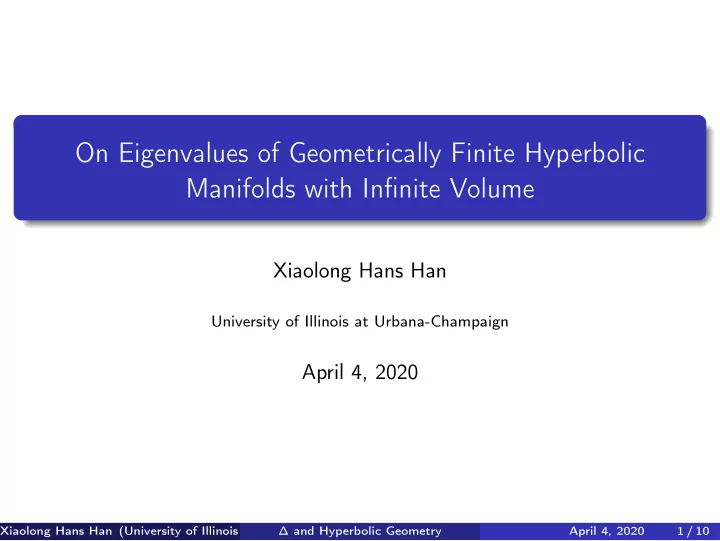

On Eigenvalues of Geometrically Finite Hyperbolic Manifolds with Infinite Volume Xiaolong Hans Han University of Illinois at Urbana-Champaign April 4, 2020 Xiaolong Hans Han (University of Illinois at Urbana-Champaign) ∆ and Hyperbolic Geometry April 4, 2020 1 / 10
Spectrum and Hyperbolic Geometry in 2-d Geometric Information from Spectrum For a planar polygon Ω , in 1966 Marc Kac proved � ∞ 1 1 k = 1 e − λ k t ∼ 2 π t area (Ω) − √ length ( ∂ Ω) 4 2 π t Curvature and Topology McKean and Singer (1967): for closed Riemannian manifold: can also recover (dimension, volume and) total curvature. In 2- d , with Gauss-Bonnet formula, we can recover Euler characteristic. Xiaolong Hans Han (University of Illinois at Urbana-Champaign) ∆ and Hyperbolic Geometry April 4, 2020 2 / 10
Weyl’s Law and Hyperbolic Manifolds Example (Number of Eigenvalues and Geometry) Weyl’s Asymptotic Formula: ( M , g ) a compact Riemannian manifold. N ( λ ) = { λ k : λ k < λ } ω n ( 2 π ) n Vol ( M ) λ n / 2 N ( λ ) ∼ Good? For Hyperbolic Manifolds Hyperbolic manifolds: H n / Γ , isometries=Mobius transformations. Similar to T 2 = R 2 / Z 2 . Volume is a geometric and hence topological invariant for finite-volume hyperbolic manifold. Xiaolong Hans Han (University of Illinois at Urbana-Champaign) ∆ and Hyperbolic Geometry April 4, 2020 3 / 10
Spectrum in Hyperbolic Manifolds Idea: Geometric data − → Data about spectrum Mckean, 1970 The bottom of the spectrum of H n is at least ( n − 1 ) 2 4 Schoen, Randol, Doziuk 1980s M finite volume hyperbolic, c λ 1 ( M ) ≥ Vol ( M ) 2 Intuition is that, no "dumbbell" phenomenon as shown by Cheeger. Xiaolong Hans Han (University of Illinois at Urbana-Champaign) ∆ and Hyperbolic Geometry April 4, 2020 4 / 10
Components of Hyperbolic Manifolds Cusps Upper half-space Model for H n , horoball and parabolic subgroup. Metric structure and volume form on a cusp: The metric structure on T : E × [ 0 , ∞ ) , E torus. Volume form ω : ω = hdx ∧ dt where h : E × [ 0 , ∞ ) → ( 0 , ∞ ) satisfies ∂ ∂ t h ( x , t ) = − ( n − 1 ) h ( x , t ) Tubes Tubular neighborhood of short geodesic, like solid torus. Ends with Infinite Volume Funnel region expanding expnonentially. Xiaolong Hans Han (University of Illinois at Urbana-Champaign) ∆ and Hyperbolic Geometry April 4, 2020 5 / 10
Figure 1: Cusp Figure 2: Tube Figure 3: End Xiaolong Hans Han (University of Illinois at Urbana-Champaign) ∆ and Hyperbolic Geometry April 4, 2020 6 / 10
Upper Bound for First Eigenvalue Hamenstadt, Mckean: Functional Inequality for Cusp f smooth with compact support on T . � � �∇ f � 2 ≥ ( n − 1 ) 2 f 2 4 T T Idea for Proof Cauchy-Schwarz Inequality and metric properties of cusps. For Tubes and Ends Similar Inequalities and Similar Proofs Xiaolong Hans Han (University of Illinois at Urbana-Champaign) ∆ and Hyperbolic Geometry April 4, 2020 7 / 10
Eigenvalues under Decomposition Hamenstadt, 2018 For every finite volume oriented Riemannian manifold M of dimension n ≥ 3 and curvature κ ∈ [ − b 2 , − 1 ] and for all k ≥ 0, we have 3 λ k ( M thick ) , ( n − 2 ) 2 λ k ( M ) ≥ min { 1 } 12 Importance Not too much is known for eigenvalues for non-compact finite-volume hyperbolic manifolds. Proposition (Hamenstadt) f : M → R is a smooth, square integrable function with Raleigh quotient R ( f ) < ( n − 2 ) 2 / 12. Then � � M f 2 ≥ 1 f 2 � 3 M Xiaolong Hans Han (University of Illinois at Urbana-Champaign) ∆ and Hyperbolic Geometry April 4, 2020 8 / 10
Decomposition of Geometrically Finite Hyperbolic Manifold with Infinite Volume M is a geometrically finite negatively curved manifold of dimension ≥ 3 with pinched curvature and infinite volume. Figure 4: Geometrically Finite Manifold with Infinite Volume Xiaolong Hans Han (University of Illinois at Urbana-Champaign) ∆ and Hyperbolic Geometry April 4, 2020 9 / 10
Main Theorem and Argument Han, 2020 Let M be a geometrically finite, oriented hyperbolic manifold M of dimension n ≥ 3 with infinite volume. Then for all k ≥ 0, we have M ) , ( n − 2 ) 2 3 λ k (( � λ k ( M ) ≥ min { 1 } 12 where r ≥ tanh − 1 ( n − 2 ) 2 ( n − 1 ) 2 and the boundary condition on � M is Neumann. Proposition (Han) f : M → R is a smooth, square integrable function with Raleigh quotient R ( f ) < ( n − 2 ) 2 / 12. Then � � M f 2 ≥ 1 f 2 � 3 M Xiaolong Hans Han (University of Illinois at Urbana-Champaign) ∆ and Hyperbolic Geometry April 4, 2020 10 / 10
Recommend
More recommend